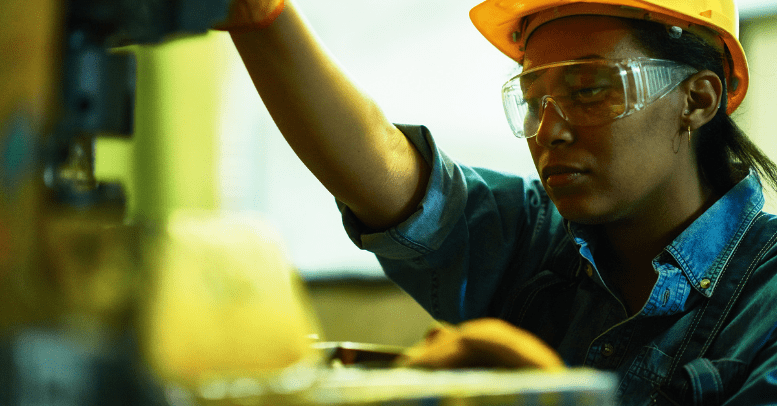Manufacturing is the backbone of everything we do. From energy to infrastructure, transportation to technology, we need to recognize and celebrate those professionals in every industrial sector. It’s even more important today as manufacturers seek to fill 4.6 million high-skill, high-tech, and high-paying jobs over the next decade. That’s why we’re supporting and celebrating Manufacturing Day all month long with the intention of educating and increasing the positive perception of working in manufacturing.
What is MFG Day (or Manufacturing Day)?
Manufacturing Day, organized nationally by The Manufacturing Institute, the 501(c)3 workforce development and education partner—helps show the reality of modern manufacturing careers by encouraging thousands of companies and educational institutions around the nation to open their doors to students, parents, teachers and community leaders. (NAM.org)
Why is it important?
By 2030, according to The Manufacturing Institute and Deloitte, manufacturers need to fill more than 4 million jobs. Right now, more than half of those jobs are at risk of going unfilled. That’s why MFG Day and Manufacturing Month are so important, to tackle this problem head on by changing the perception of modern manufacturing and recruiting new manufacturing talent. (CreatorsWanted.org)
Check out Figure 1 for even more on the skills. Between the predicted retirements and natural job growth, there will be millions of manufacturing jobs to fill between now and 2028. Based on data sourced from BLS, Oxford Economics Model, Deloitte, and The Manufacturing Institute, less than half of those jobs are likely to be filled.
What can be done?
In addition to spreading awareness and supporting events like MFG Day, we can set ambitious, not just realistic goals for the future. CreatorsWanted.org is an organization doing just that. Their mission is to focus on three initiatives by 2025: reduce the skills gap in the US (United States) by 600,000, increase the number of students enrolling in technical and vocational schools or reskilling programs by 25%, and increase the positive perception of the industry among parents to 50% from 27%.
Manufacturers can also help with perception and job retention. Educating a diverse group of employable candidates in the opportunities and benefits of a manufacturing career is one way the industry can improve. As Karen Norheim, president and COO (Chief Operating Officer) of American Crane and Equipment Corporation and 2019 national chair of the Women in Manufacturing (WiM) Board of Directors, clearly expressed, “The more perspectives on the problem, the better the solution will be.” (ThomasNet.com)
Organizations can also improve recruiting efforts, develop a strong company culture, and offer on-going training opportunities and educational resources.
The good news is there are numerous ways to improve. Pete Cirak, Quality Assurance Director at Seal Dynamics, suggests “Manufacturers should regularly join their regional manufacturing associations, local educational institutions, and community career and workforce development offices.”
How can you use the Omnia assessment for filling manufacturing positions on the floor and/or in the office?
Our most popular pre-employment assessment gives you a deeper understanding of a candidate’s personality, workplace preferences, and motivators—plus how those traits will affect their performance in the role you’re looking to fill. Additionally, The Omnia Group provides benchmarks for manufacturing specific positions, such as Heavy Equipment Operator, Sourcing Manager and Operations Manager, to help identify the candidates with the best-fit traits for the position. This information is invaluable to your hiring process because these are traits that can’t simply be uncovered from a resume or short interview.
The Omnia Group also offers a cognitive assessment. This helps identify candidates with the capacity to cross-train efficiently and effectively, versus those candidates who are likely to thrive in a more consistent role. This employee aptitude test evaluates a candidate’s ability to think, reason, and solve problems, allowing you to quickly identify if an individual has the problem-solving aptitude and reasoning ability to function at peak performance in a new role before investing valuable time and resources in training.
How can the Omnia assessment give you more confidence in your hiring decisions and retention strategies through Covid and the inevitable skills gap?
Assessments aren’t just for hiring. They can be an easy way to identify your employees’ motivations enabling them to meet their greatest potential. They are also great for identifying why one team may be high-performing, while another is falling behind. They can even help when companies are experiencing high turnover by showing key motivators and challenges to address for improving morale rather than letting the turnover continue.
Another use for assessments is finding employees who would be good mentors. Manufacturing is experiencing a resurgence of apprenticeship programs. They’re critical to closing the skill gap. According to Cirak, “Apprenticeships and internships are arguably the best approaches to creating a structured talent pipeline for a manufacturing company, yet few companies provide either opportunity.”
What’s Beyond Manufacturing Day?
As manufacturers seek to fill 4.6 million high-skill, high-tech, and high-paying jobs over the next decade, we stand with them through MFG Day and beyond. We recognize the necessity in empowering manufacturers to come together to address their collective challenges so they can help their communities and future generations thrive. We proudly sponsor events and support our local BAMA (Bay Area Manufacturers Association) and SAMA (San Antonio Manufacturers Association) chapters. For more information on how Omnia can help your organization, contact us.























